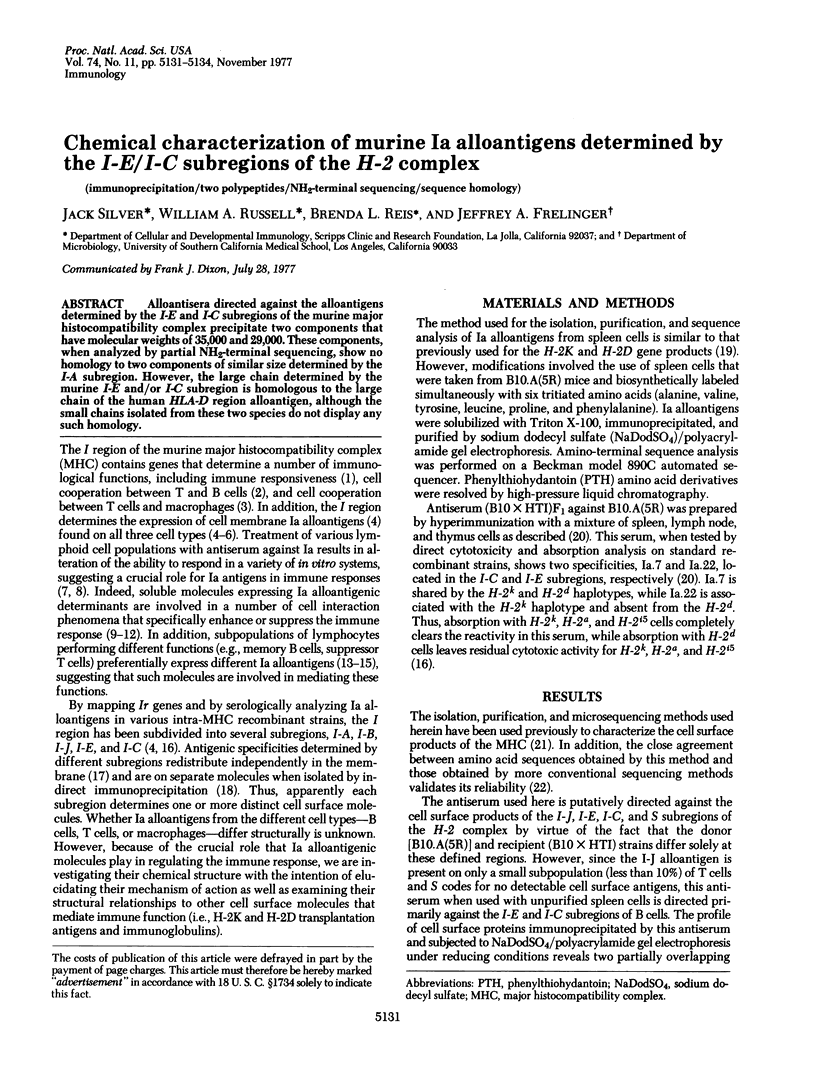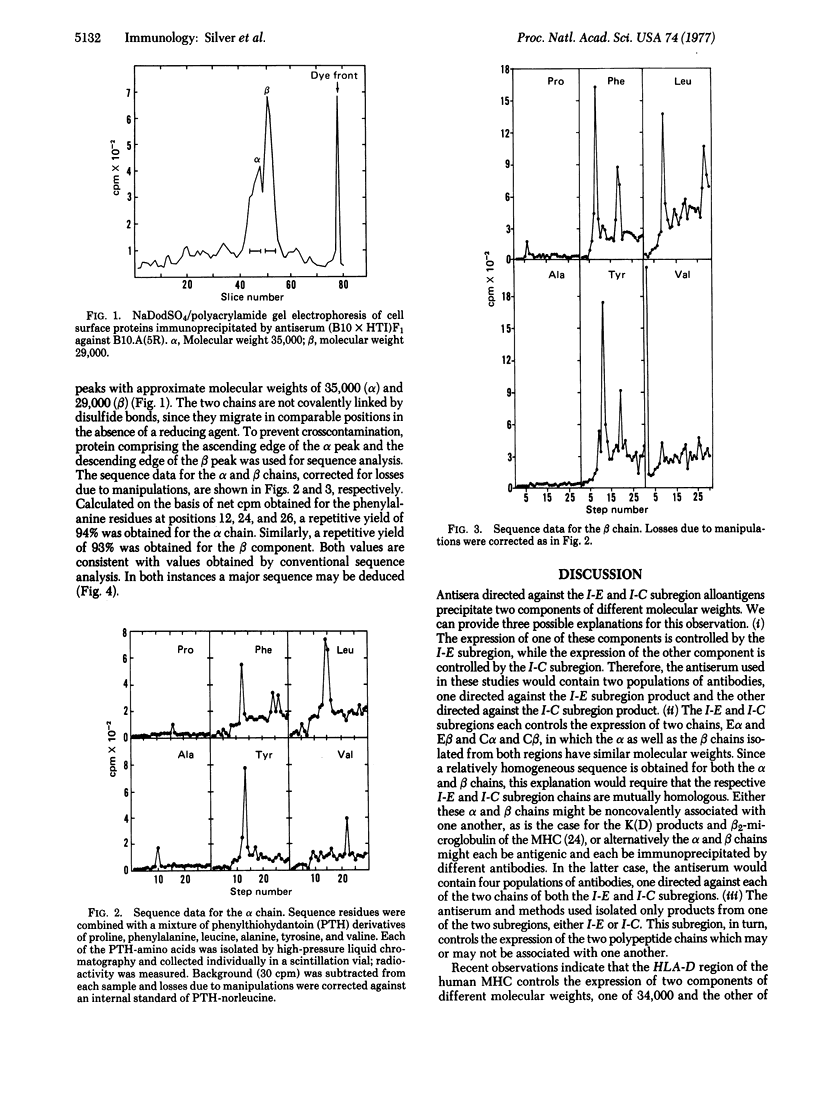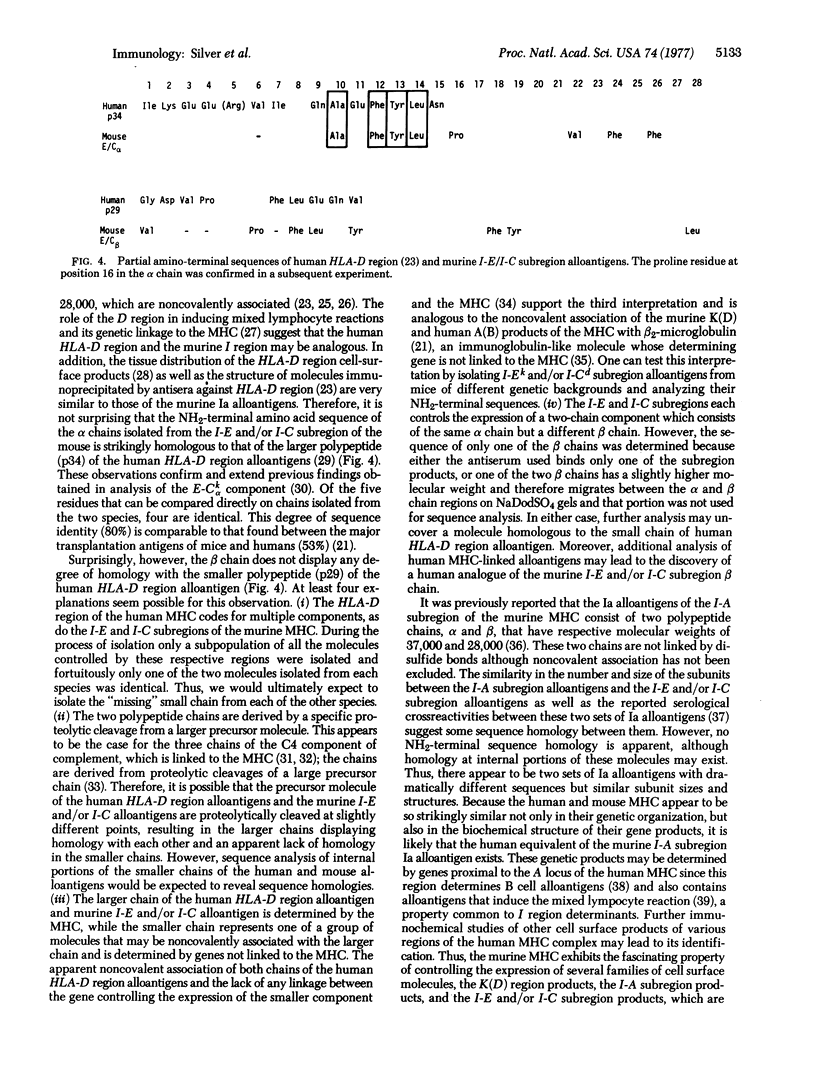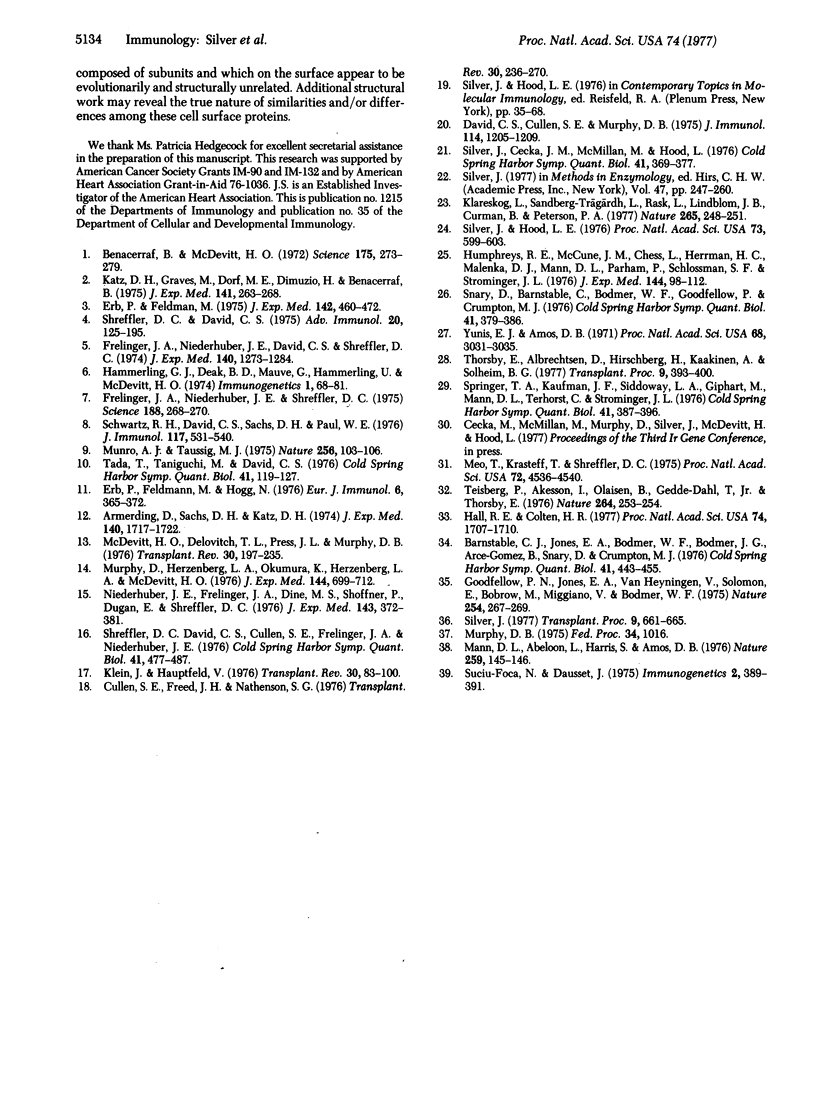Abstract
Alloantisera directed against the alloantigens determined by the I-E and I-C subregions of the murine major histocompatibility complex precipitate two components that have molecular weights of 35,000 and 29,000. These components, when analyzed by partial NH2-terminal sequencing, show no homology to two components of similar size determined by the I-A subregion. However, the large chain determined by the murine I-E and/or I-C subregion is homologous to the large chain of the human HLA-D region alloantigen, although the small chains isolated from these two species do not display any such homology.
Full text
PDF



Selected References
These references are in PubMed. This may not be the complete list of references from this article.
- Armerding D., Sachs D. H., Katz D. H. Activation of T and B lymphocytes in vitro. III. Presence of Ia determinants on allogeneic effect factor. J Exp Med. 1974 Dec 1;140(6):1717–1722. doi: 10.1084/jem.140.6.1717. [DOI] [PMC free article] [PubMed] [Google Scholar]
- Barnstable C. J., Jones E. A., Bodmer W. F., Bodmer J. G., Arce-Gomez B., Snary D., Crumpton M. J. Genetics and serology of HL-A-linked human Ia antigens. Cold Spring Harb Symp Quant Biol. 1977;41(Pt 2):443–455. doi: 10.1101/sqb.1977.041.01.052. [DOI] [PubMed] [Google Scholar]
- Benacerraf B., McDevitt H. O. Histocompatibility-linked immune response genes. Science. 1972 Jan 21;175(4019):273–279. doi: 10.1126/science.175.4019.273. [DOI] [PubMed] [Google Scholar]
- Cullen S. E., Freed J. H., Nathenson S. G. Structural and serological properties of murine Ia alloantigens. Transplant Rev. 1976;30:236–270. doi: 10.1111/j.1600-065x.1976.tb00222.x. [DOI] [PubMed] [Google Scholar]
- David C. S., Cullen S. E., Murphy D. B. Serologic and biochemical studies of the Ia system of the mouse H-2 gene complex. Further evidence for I-C subregion. J Immunol. 1975 Apr;114(4):1205–1209. [PubMed] [Google Scholar]
- Erb P., Feldmann M., Hogg N. Role of macrophages in the generation of T helper cells. IV. Nature of genetically related factor derived from macrophages incubated with soluble antigens. Eur J Immunol. 1976 May;6(5):365–372. doi: 10.1002/eji.1830060512. [DOI] [PubMed] [Google Scholar]
- Erb P., Feldmann M. The role of macrophages in the generation of T-helper cells. II. The genetic control of the macrophage-T-cell interaction for helper cell induction with soluble antigens. J Exp Med. 1975 Aug 1;142(2):460–472. doi: 10.1084/jem.142.2.460. [DOI] [PMC free article] [PubMed] [Google Scholar]
- Frelinger J. A., Neiderhuber J. E., David C. S., Shreffler D. C. Evidence for the expression of Ia (H-2-associated) antigens on thymus-derived lymphocytes. J Exp Med. 1974 Nov 1;140(5):1273–1284. doi: 10.1084/jem.140.5.1273. [DOI] [PMC free article] [PubMed] [Google Scholar]
- Frelinger J. A., Niederhuber J. E., Shreffler D. C. Inhibition of immune responses in vitro by specific antiserums to Ia antigens. Science. 1975 Apr 18;188(4185):268–270. doi: 10.1126/science.1118728. [DOI] [PubMed] [Google Scholar]
- Goodfellow P. N., Jones E. A., Van Heyningen V., Solomon E., Bobrow M., Miggiano V., Bodmer W. F. The beta2-microglobulin gene is on chromosome 15 and not in the HL-A region. Nature. 1975 Mar 20;254(5497):267–269. doi: 10.1038/254267a0. [DOI] [PubMed] [Google Scholar]
- Hall R. E., Colten H. R. Cell-free synthesis of the fourth component of guinea pig complement (C4): identification of a precursor of serum C4 (pro-C4). Proc Natl Acad Sci U S A. 1977 Apr;74(4):1707–1710. doi: 10.1073/pnas.74.4.1707. [DOI] [PMC free article] [PubMed] [Google Scholar]
- Humphreys R. E., McCune J. M., Chess L., Herrman H. C., Malenka D. J., Mann D. L., Parham P., Schlossman S. F., Strominger J. L. Isolation and immunologic characterization of a human. B-lymphocyte-specific, cell surface antigen. J Exp Med. 1976 Jul 1;144(1):98–112. doi: 10.1084/jem.144.1.98. [DOI] [PMC free article] [PubMed] [Google Scholar]
- Katz D. H., Graves M., Dorf M. E., Dimuzio H., Benacerraf B. Cell interactions between histoincompatible T and B lymphocytes. VII. Cooperative responses between lymphocytes are controlled by genes in the I region of the H-2 complex. J Exp Med. 1975 Jan 1;141(1):263–268. doi: 10.1084/jem.141.1.263. [DOI] [PMC free article] [PubMed] [Google Scholar]
- Klareskog L., Sandgerg-Trägårdh L., Rask L., Lindblom J. B., Curman B., Peterson P. A. Chemical properties of human Ia antigens. Nature. 1977 Jan 20;265(5591):248–251. doi: 10.1038/265248a0. [DOI] [PubMed] [Google Scholar]
- Klein J., Hauptfeld V. Ia antigens: their serology, molecular relationships, and their role in allograft reactions. Transplant Rev. 1976;30:83–100. [PubMed] [Google Scholar]
- Mann D. L., Abelson L., Harris S., Amos D. B. Second genetic locus in the HLA region for human B-cell alloantigens. Nature. 1976 Jan 15;259(5539):145–146. doi: 10.1038/259145a0. [DOI] [PubMed] [Google Scholar]
- McDevitt H. O., Delovitch T. L., Press J. L., Murphy D. B. Genetic and functional analysis of the Ia antigens: their possible role in regulating the immune response. Transplant Rev. 1976;30:197–235. doi: 10.1111/j.1600-065x.1976.tb00221.x. [DOI] [PubMed] [Google Scholar]
- Meo T., Krasteff T., Shreffler D. C. Immunochemical characterization of murine H-2 controlled Ss (serum substance) protein through identification of its human homologue as the fourth component of complement. Proc Natl Acad Sci U S A. 1975 Nov;72(11):4536–4540. doi: 10.1073/pnas.72.11.4536. [DOI] [PMC free article] [PubMed] [Google Scholar]
- Munro A. J., Taussig M. J. Two genes in the major histocompatibility complex control immune response. Nature. 1975 Jul 10;256(5513):103–106. doi: 10.1038/256103a0. [DOI] [PMC free article] [PubMed] [Google Scholar]
- Murphy D. B., Herzenberg L. A., Okumura K., Herzenberg L. A., McDevitt H. O. A new I subregion (I-J) marked by a locus (Ia-4) controlling surface determinants on suppressor T lymphocytes. J Exp Med. 1976 Sep 1;144(3):699–712. doi: 10.1084/jem.144.3.699. [DOI] [PMC free article] [PubMed] [Google Scholar]
- Niederhuber J. E., Frelinger J. A., Dine M. S., Shoffner P., Dugan E., Shreffler D. C. Effects of anti-Ia sera on mitogenic responses. II. Differential expression of the Ia marker on phytohemagglutinin and concanavalin A-reactive T cells. J Exp Med. 1976 Feb 1;143(2):372–381. doi: 10.1084/jem.143.2.372. [DOI] [PMC free article] [PubMed] [Google Scholar]
- Schwartz R. H., David C. S., Sachs D. H., Paul W. E. T lymphocyte-enriched murine peritoneal exudate cells. III. Inhibition of antigen-induced T lymphocyte Proliferation with anti-Ia antisera. J Immunol. 1976 Aug;117(2):531–540. [PubMed] [Google Scholar]
- Shreffler D. C., David C. S., Cullen S. E., Frelinger J. A., Niederhuber J. E. Serological and functional evidence for further subdivision of the I regions of the H-2 gene complex. Cold Spring Harb Symp Quant Biol. 1977;41(Pt 2):477–487. doi: 10.1101/sqb.1977.041.01.055. [DOI] [PubMed] [Google Scholar]
- Shreffler D. C., David C. S. The H-2 major histocompatibility complex and the I immune response region: genetic variation, function, and organization. Adv Immunol. 1975;20:125–195. doi: 10.1016/s0065-2776(08)60208-4. [DOI] [PubMed] [Google Scholar]
- Silver J., Cecka J. M., McMillan M., Hood L. Chemical characterization of products of the H-2 complex. Cold Spring Harb Symp Quant Biol. 1977;41(Pt 1):369–377. doi: 10.1101/sqb.1977.041.01.044. [DOI] [PubMed] [Google Scholar]
- Silver J., Hood L. Structure and evolution of transplantation antigens: partial amino-acid sequences of H-2K and H-2D alloantigens. Proc Natl Acad Sci U S A. 1976 Feb;73(2):599–603. doi: 10.1073/pnas.73.2.599. [DOI] [PMC free article] [PubMed] [Google Scholar]
- Silver J. Microsequence analysis in automated spinning-cup sequenators. Methods Enzymol. 1977;47:247–260. doi: 10.1016/0076-6879(77)47029-0. [DOI] [PubMed] [Google Scholar]
- Silver J. Partial amino acid sequences of Ia alloantigens. Transplant Proc. 1977 Mar;9(1):661–665. [PubMed] [Google Scholar]
- Snary D., Barnstable C., Bodmer W. F., Goodfellow P., Crumpton M. J. Human Ia antigens--purification and molecular structure. Cold Spring Harb Symp Quant Biol. 1977;41(Pt 1):379–386. doi: 10.1101/sqb.1977.041.01.045. [DOI] [PubMed] [Google Scholar]
- Springer T. A., Kaufman J. F., Siddoway L. A., Giphart M., Mann D. L., Terhorst C., Strominger J. L. Chemical and immunological characterization of HL-A linked B-lymphocyte alloantigens. Cold Spring Harb Symp Quant Biol. 1977;41(Pt 1):387–396. doi: 10.1101/sqb.1977.041.01.046. [DOI] [PubMed] [Google Scholar]
- Tada T., Taniguchi M., David C. S. Suppressive and enhancing T-cell factors as I-region gene products: properties and the subregion assignment. Cold Spring Harb Symp Quant Biol. 1977;41(Pt 1):119–127. doi: 10.1101/sqb.1977.041.01.016. [DOI] [PubMed] [Google Scholar]
- Teisberg P., Akesson I., Olaisen B., Gedde-Dahl T., Jr, Thorsby E. Genetic polymorphism of C4 in man and localisation of a structural C4 locus to the HLA gene complex of chromosome 6. Nature. 1976 Nov 18;264(5583):253–254. doi: 10.1038/264253a0. [DOI] [PubMed] [Google Scholar]
- Thorsby E., Albrechtsen D., Hirschberg H., Kaakinen A., Solheim B. G. MLC-activating HLA-D determinants: identification, tissue distribution, and significance. Transplant Proc. 1977 Mar;9(1):393–400. [PubMed] [Google Scholar]
- Yunis E. J., Amos D. B. Three closely linked genetic systems relevant to transplantation. Proc Natl Acad Sci U S A. 1971 Dec;68(12):3031–3035. doi: 10.1073/pnas.68.12.3031. [DOI] [PMC free article] [PubMed] [Google Scholar]


